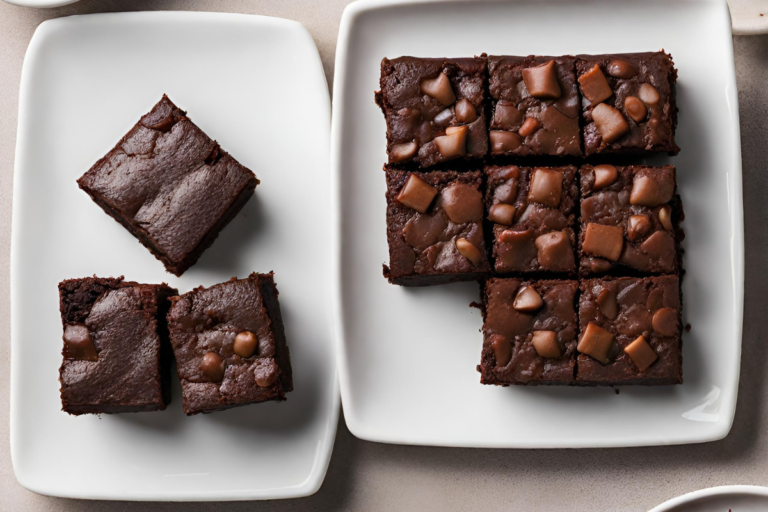What Are the Two Types of Brownies and What Causes the Difference?
Brownies are one of those desserts you can’t help but love. Whether they’re fudgy and gooey or cakey and fluffy, they always hit the spot. The key to understanding brownies is knowing that there are two main types: fudgy and cakey. But what causes these differences? In this article, we’ll explore the factors that make brownies unique and dive into what makes them fudgy or cakey.
The Characteristics of the Two Types of Brownies
- Fudgy Brownies: What Sets Them Apart
When you think of a fudgy brownie, you imagine a dense, gooey treat that’s almost truffle-like. These brownies are packed with rich chocolate flavor and have a moist consistency that feels decadent. The secret to achieving this texture lies in the fat-to-flour ratio. More fat, usually from butter and chocolate, with less flour, is the key to achieving that fudgy consistency.
Also, melting the butter with the chocolate plays a significant role in creating fudgy brownies. This method ensures that the mixture remains rich and smooth. It’s not just about the ingredients; it’s also about the process. As you bake these brownies, be careful not to overbake them; they continue cooking while they cool.
- Cakey Brownies: What Makes Them Different from Fudgy Brownies
On the other hand, cakey brownies are a completely different story. They’re lighter and fluffier, with a texture closer to a soft cake. Cakey brownies contain more flour, often with a bit of baking powder for leavening. This creates a softer and airier consistency.
The way you mix the ingredients matters too. Creaming the butter and sugar introduces air into the batter, which contributes to the cake-like structure. Cakey brownies are ideal for those who prefer a lighter dessert that’s not overly dense.
These two types of brownies are just the beginning. In the next part, we’ll explore what causes these differences in more detail and delve into the specifics of the fat-to-flour ratio and mixing techniques (The Wimpy Vegetarian) (Kitchen).
What Causes the Two Types of Brownies to Be Different?
- Fat-to-Flour Ratio: The Key Factor for Brownie Texture
The fat-to-flour ratio is a critical factor in determining the type of brownie you’ll end up with. In fudgy brownies, there’s a higher fat content and less flour. This balance creates the dense, rich texture you crave when you’re in the mood for something decadent. The extra fat generally comes from butter and chocolate, giving fudgy brownies their moistness and gooey consistency.
For cakey brownies, there’s more flour and slightly less fat. This shift in ratio creates a lighter, fluffier texture, more reminiscent of cake than a rich dessert. Adding baking powder or baking soda can also contribute to this airy feel by providing some leavening, allowing the brownies to rise as they bake (Kitchn).
- Mixing Techniques: How They Impact Brownies Texture
How you mix the ingredients plays a significant role in achieving your desired texture. For fudgy brownies, you’ll often melt butter with chocolate, creating a smooth and rich base. This technique minimizes air in the batter, resulting in a dense, fudgy interior. Melting butter and sugar together has a similar effect, helping to achieve that coveted shiny crust and dense texture (King Arthur Baking).
On the other hand, cakey brownies require a different approach. By creaming butter and sugar, you introduce air into the mix, leading to a lighter, more cake-like structure. This process also helps the brownies rise during baking, contributing to their soft texture (Kitchn).
Understanding these factors is the key to customizing your brownie recipes and achieving the perfect consistency. Next, we’ll explore the many variations of brownies and how different ingredients and toppings can create unique flavors and textures (The Wimpy Vegetarian).
Exploring Unique Brownie Varieties
- Innovative Brownie Types: Beyond Fudgy and Cakey
Besides the classic fudgy and cakey types, brownies come in a variety of unique forms that cater to different tastes. Let’s start with swirl and layered brownies. These creative treats often have a classic brownie base but are swirled with ribbons of cheesecake, caramel, or other flavorful fillings. Layered brownies take it a step further with distinct layers, like cookie dough or marshmallow fluff (Recipes Buffet).
Mix-ins are another popular way to add variety to brownies. By incorporating chocolate chips, nuts, or even dried fruit into the batter, you get a more complex texture and flavor profile. Toppings, like a drizzle of salted caramel or a sprinkle of sea salt, can transform a regular brownie into a gourmet dessert. These variations are perfect for those who enjoy experimenting in the kitchen (The Wimpy Vegetarian).
- Swirl and Layered Brownies: Adding Visual Appeal
Beyond the traditional fudgy and cakey brownies, some popular recipes stand out for their creativity and flavor combinations. For instance, pecan brownies add a delightful crunch and a buttery flavor that complements the rich chocolate base (The Wimpy Vegetarian). Nutella brownies are another favorite, with their indulgent swirls of chocolate hazelnut spread throughout the brownie batter.
If you prefer a more classic combination, consider peanut butter brownies. These treats combine the richness of chocolate with the nutty goodness of peanut butter. Whether swirled or layered, these brownies offer a delicious twist on a traditional dessert. Caramel brownies and cheesecake brownies are also popular options, bringing additional layers of flavor to the mix (The Wimpy Vegetarian) (L’Academie de Cuisine).
In the next section, we’ll discuss essential tips for baking the perfect brownie and how to avoid common baking mistakes to ensure your brownies turn out just the way you like them (Handle the Heat).

Tips for Baking the Perfect Brownie
- Perfecting the Two Types of Brownies: Tips and Techniques
Baking the perfect brownie involves more than just throwing ingredients into a bowl and hoping for the best. First and foremost, quality matters. Use high-quality chocolate and cocoa powder, as these ingredients will impact the flavor and texture of your brownies. Opt for unsweetened or bittersweet chocolate for a more intense chocolate flavor, and use Dutch-processed cocoa for a deeper color and richness (Kitchn).
Another critical tip is to be careful about mixing. Overworking the batter can lead to tough brownies, so it’s crucial to fold the flour in gently. When baking, avoid overbaking by setting a timer and checking the brownies regularly. Remember, they continue cooking while cooling, so a slight underbake is usually a good idea to maintain moisture and gooeyness (Recipes Buffet).
- Avoiding Common Baking Mistakes: How to Keep Your Brownies Soft and Gooey
For fudgy brownies, the key is to minimize air in the batter. Melting the butter and sugar together helps create a denser, fudgy texture, while also contributing to a shiny, crackly top crust (King Arthur Baking). Adding an extra egg yolk to the batter can also enhance fudginess, as egg yolks add richness and moisture.
Cakey brownies require a different approach. Creaming butter and sugar introduces air into the batter, creating a lighter texture. The use of baking powder or baking soda helps achieve a cake-like structure and contributes to the rise of the brownies during baking (Kitchn).
These techniques can help you achieve the perfect brownie texture, whether you prefer fudgy or cakey. Up next, we’ll tackle some common FAQs about brownies and how to address common issues that bakers often encounter (Rich And Delish).


